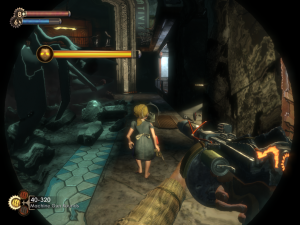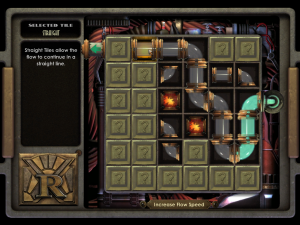Combat: Bosses
I still haven’t reached Combat‘s thirtieth and presumably final level. I think I’ve got up to level 29, but that one’s a real killer. Since all I likely have ahead of me is the end boss, let’s take a look at the other bosses I’ve encountered so far.
The first one you encounter is a spinning octagonal lump that bounces around inside a large square arena. It periodically extends four symmetrically-arranged arms radially until they hit the edge, then sweeps them around for a while, forcing you to circle around with them if you don’t want to get hurt. Each arm ends in a clearly-shootable pod, which explodes, destroying the arm, after a little persistence — the easiest approach is to follow one along an edge so you can keep it lined up with your gun. After all four arms are gone, they’re replaced with guns, which you also have to destroy one by one. It’s pretty straightforward.
Level 10 puts us in a sort of maze — not a complicated one, but large, in the sense that the hallways are wide and long. An armored contraption shaped sort of like a minibus patrols this maze, shooting barrages of unusually large bullets and moving far faster than you can go without a speed boost powerup (of which there are several to be found). Fighting it involves shooting from a distance and running away a lot — the temptation is to face off squarely against it, because that works on most enemies, but it’s just the wrong approach here. This is the boss that guards the first automatic save point, and I remember having a very difficult time of it at first, because I couldn’t tell if I was damaging it or not. Unlike the previous boss, it had no obvious vulnerable spots, and no isolated weapon bits to shoot off. All I could do is keep on pelting it and hope that I was having an effect.
The third boss is actually two, a pair of modestly-oversized tanks running on concentric tracks around a solid obstacle, circling faster than your tank can move. The floor drops away on either side of the tracks, as well as between them; there are only a few spots where you can stand with no danger of being run over, and if you just sit motionless on one of those spots, you’ll just get shot instead. However, killing either one of the two tanks means that you can move to its track and safely dodge fire from the other. This is one of the less-satisfying boss levels, mainly because it was so hard to avoid getting hurt that it didn’t seem worth bothering, but also in part because the enemies here just don’t seem as impressive as the others.
The fourth boss is essentially a very big turret, sitting in the void, stationary but rotating to face you as you move around on a U-shaped ledge. It has multiple guns, some firing multiple sprays of scattering bullets, some firing bombs that do splash damage, and apparently some firing souped-up jets, themselves capable of shooting at you. (This last touch was proabably necessary to keep the fight from getting monotonous. Without the jets, the focus of the action would always be on the turret, whether aiming at it or dodging it.) Mainly you pass this stuff by just constantly keeping in motion, which is a good idea in most situations anyway. After the last of the conventional guns goes down, the turret’s outer casing falls off to reveal the last line of defense: a sweeping beam weapon. Just like in a whole bunch of vertical-scrolling shooters, it takes a little while to power up, and then fires continuously for long enough to corner you if you didn’t rush to the other side when you heard the about-to-fire-beam-weapon audio cue.
Level 25 puts you in an open arena with a few unnavigable holes. The boss, however, it puts outside this arena. Just as the level 20 boss was a very large turret, this boss is a very large jet. It goes through a cycle of several attack patterns: zooming across the battlefield to ram you, summoning smaller jets, firing its scatter-guns, laying a line of bombs, using the same sort of sweeping beam as in the end of level 20. The scatter-guns can be destroyed individually, but this just knocks that attack out of the cycle. The peculiar thing is that it’s only shootable at certain moments in its routine. It only descends to tank-level when the attack it’s attempting makes it necessary.
My guess is that the final boss will be a massive tank, because the ending is the time to reiterate the game’s main theme, especially if you’ve been going with variations for a while. But that doesn’t tell me much about what the fight will be like. Because really, when you come down to it, the main thing that distinguishes the boss fights in this game from each other isn’t the bosses so much as the terrain, and the boss’s relation to it. That’s the thing that determines how the player can respond to them, whether it’s possible to dodge or hide, etc.
 Comments(0)
Comments(0)

